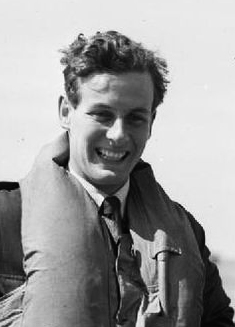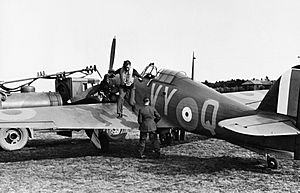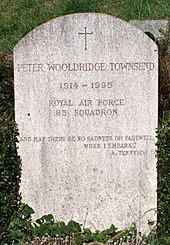Peter Townsend (RAF officer) facts for kids
Quick facts for kids
Peter Townsend
|
|
|---|---|

Flight Lieutenant Townsend in 1940
|
|
| Born | 22 November 1914 Rangoon, Burma, British India (now Yangon, Myanmar) |
| Died | 19 June 1995 (aged 80) Saint-Léger-en-Yvelines, France |
| Buried |
Saint-Léger-en-Yvelines
|
| Allegiance | United Kingdom |
| Service/ |
Royal Air Force |
| Years of service | 1930–1955 |
| Rank | Group Captain |
| Commands held |
|
| Battles/wars | Second World War |
| Awards |
|
| Spouse(s) |
Rosemary Pawle
(m. 1941; div. 1952)Marie-Luce Jamagne
(m. 1959) |
| Children | 5 |
Group Captain Peter Wooldridge Townsend (born 22 November 1914 – died 19 June 1995) was a brave British Royal Air Force officer. He was a skilled pilot, known as a "flying ace" for shooting down many enemy planes. He also worked for the Royal Family, helping King George VI and Queen Elizabeth II. Later in life, he became a writer. Peter Townsend was also known for his romance with Princess Margaret, Queen Elizabeth's younger sister.
Contents
Early Life and Education
Peter Townsend was born in Rangoon, Burma (now Myanmar). His father was a doctor's son and an officer in the Indian Army. Peter's family often had members who joined the church or the military.
From 1928 to 1932, Peter went to Haileybury and Imperial Service College. This was a private school for boys in the United Kingdom.
RAF Career Highlights
Peter Townsend joined the Royal Air Force (RAF) in 1930. He trained to become a pilot at RAF Cranwell. In 1935, he became a pilot officer. He flew Hawker Fury fighter planes with No. 1 Squadron RAF. Later, he flew torpedo bombers in Singapore.
Fighting in World War II
In 1940, during the Second World War, Peter Townsend became famous. He was one of the first pilots to shoot down an enemy aircraft over England. This happened on 3 February 1940, when his team shot down a German Heinkel 111 bomber. He shot down more enemy planes in the following months.
For his bravery, Peter Townsend received the Distinguished Flying Cross (DFC) in April 1940. This award is given for courage and devotion to duty while flying.

By May 1940, Townsend was a skilled squadron leader. He led No. 85 Squadron RAF during the Battle of Britain. This was a very important air battle where the RAF defended Britain from German attacks. On 11 July 1940, his plane was hit by enemy fire. He had to land his plane in the sea but was rescued. He was recognized for his brave actions that month.
On 31 August, during another fight, Townsend's plane was shot down. He was wounded in his left foot. Even with his injury, he continued to lead his squadron from the ground. He returned to flying missions on 21 September. He received a second DFC award (a "Bar" to his DFC) for leading his squadron. His leadership helped destroy many enemy aircraft.
Later Wartime Service
In 1941, Peter Townsend became an acting wing commander. He had shot down at least 11 enemy aircraft by this time. He was awarded the Distinguished Service Order (DSO). This award is given for excellent leadership and bravery in battle.
After his combat flying, Townsend held several important roles. He commanded RAF Drem in Scotland and led a Spitfire unit. He also commanded a night fighter unit. In 1943, he became the commanding officer of RAF West Malling. During the war, he was credited with destroying nine enemy aircraft and sharing in the destruction of two others.
Royal Service and Retirement
In 1944, Peter Townsend was chosen to be an "equerry" to King George VI. An equerry is an officer who helps and serves the King. Townsend had previously been the King's flight instructor. He continued to serve the Royal Family until 1953. He was promoted to group captain in 1953 and retired from his royal duties that same year.
From 1953 to 1956, Townsend worked as an "air attaché" in Brussels. This meant he was a diplomat representing the British Air Force.
Later Life and Writing
After leaving the RAF, Peter Townsend spent much of his time writing books. He wrote non-fiction books about his experiences and other historical events.
Some of his books include:
- Earth My Friend: About his journey driving and boating around the world.
- Duel of Eagles: About the Battle of Britain.
- The Last Emperor: A biography of King George VI.
- The Postman of Nagasaki: About the atomic bombing of Nagasaki.
- Time and Chance: His own life story.
He also worked as a military advisor for the film Battle of Britain (1969). This film was about the air battles he fought in.
Personal Life
In 1941, Peter Townsend married Rosemary Pawle. They had two sons, Giles and Hugo. The family lived in Adelaide Cottage for a time. Peter and Rosemary divorced in 1952.
Romance with Princess Margaret
After his divorce, Peter Townsend became close to Princess Margaret, Queen Elizabeth's younger sister. He had met her while working for her father, King George VI. They wanted to get married. However, at that time, the rules of the Church of England made it very difficult for divorced people to remarry if their former spouse was still alive.
Because of these rules, their relationship caused a lot of discussion. The government sent Townsend to work in Brussels. On 31 October 1955, Princess Margaret announced that she would not marry Peter Townsend. She said she put her duty to the Commonwealth and the Church's teachings first.
Second Marriage
In 1959, Peter Townsend married Marie-Luce Jamagne, a Belgian woman. He was 45, and she was 20. They had two daughters and one son. Their younger daughter, Isabelle Townsend, later became a model.
Death and Legacy
Peter Townsend died in 1995 from stomach cancer in France. He was 80 years old. People remembered him as a brave pilot and a significant figure in royal history.
In 2002, a sculpture of Peter Townsend was put up at Townsend Square in Kings Hill. This area was once the RAF West Malling airfield, where he served.
Selected Works
- Earth My Friend
- Duel of Eagles
- The Odds Against Us (also known as Duel in the Dark)
- The Last Emperor
- The Girl in the White Ship
- The Postman of Nagasaki
- Time and Chance


